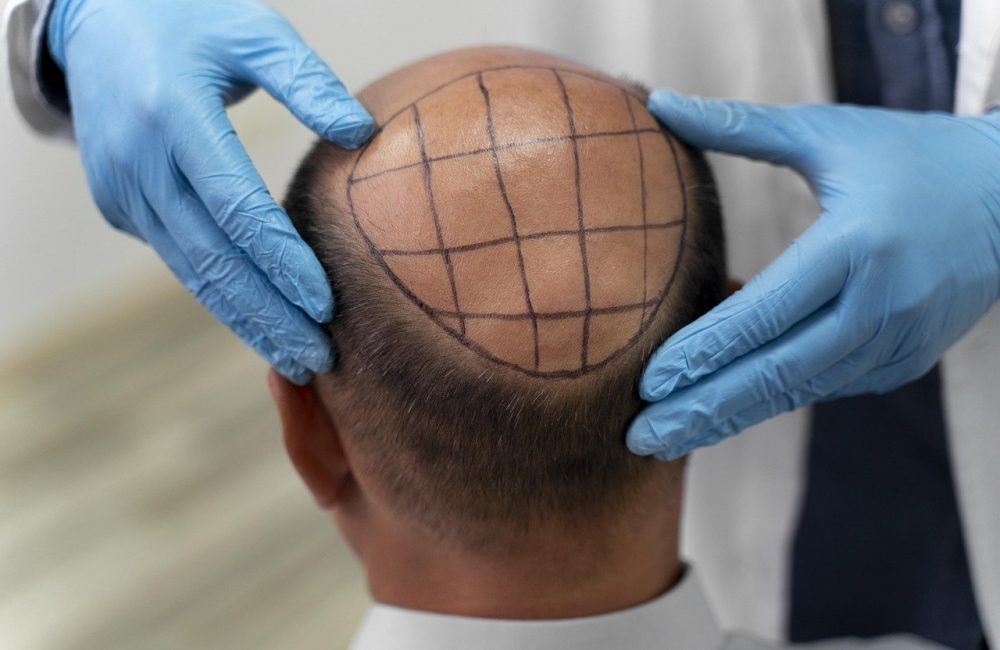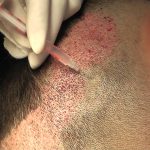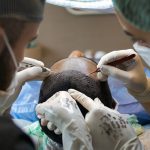11 Techniques To Reduce Pain And Discomfort During Hair Transplant Procedures

1. Topical Anesthetic Cream:
The application of a topical anesthetic cream prior to the hair transplant procedure can help numb the scalp, reducing the sensation of pain during the process. This cream is applied to the targeted area and left for a short duration to allow for effective numbing. It contains ingredients that work to block pain receptors on the skin surface, providing a localized anesthetic effect. Patients often report feeling minimal to no discomfort during the procedure when a topical anesthetic cream is used.
2. Local Anesthesia:
Local anesthesia is commonly used during hair transplant procedures to block the sensation of pain in the scalp. This can significantly reduce discomfort for the patient. The anesthesia is administered directly to the scalp using injections, effectively numbing the area where the hair transplant will take place. The dosage and application of local anesthesia are carefully controlled by the medical team to ensure the patient’s comfort throughout the procedure. Local anesthesia typically provides a numbness that lasts for the duration of the surgery.
3. Cold Compress:
Using a cold compress on the scalp before and after the procedure can help numb the area, reducing pain and swelling. The cold temperature constricts blood vessels, which can help to dull the sensation of pain and decrease inflammation. Applying a cold compress before the procedure can prepare the scalp for the upcoming treatment, while using it afterward can provide relief from any discomfort or swelling that may occur. Cold compresses are a simple yet effective way to manage post-operative pain and promote healing.
4. Relaxation Techniques:
Teaching patients relaxation techniques such as deep breathing exercises can help reduce anxiety and discomfort during the hair transplant procedure. Deep breathing can promote relaxation by calming the nervous system and easing tension in the body. By incorporating relaxation techniques before and during the procedure, patients can better manage any stress or discomfort they may experience. Medical staff can guide patients in utilizing these techniques to create a more soothing and comfortable environment during the hair transplant process.
5. Distraction:
Providing patients with distractions such as music, movies, or audiobooks during the procedure can help take their mind off any discomfort. Engaging patients in enjoyable activities or entertainment can shift their focus away from the procedure itself, making the experience more bearable. Distraction techniques can help reduce feelings of anxiety and pain by creating a more positive and relaxed atmosphere. By offering various forms of distraction, medical professionals can cater to individual patient preferences and enhance their overall comfort.
6. Proper Positioning:
Ensuring the patient is in a comfortable position during the procedure can help reduce muscle tension and discomfort. Proper positioning is crucial for optimizing the patient’s comfort and allowing the medical team to perform the hair transplant with precision. Patients should be supported in a way that minimizes strain on their body and promotes relaxation. By making adjustments to the patient’s position as needed, healthcare providers can ensure a more comfortable and stress-free experience for the individual undergoing the procedure.
7. Gentle Handling:
Using gentle and precise techniques during the hair transplant procedure can minimize trauma to the scalp, leading to less post-operative pain. Gentle handling of the scalp and hair follicles is essential to prevent unnecessary discomfort and reduce the risk of complications. By employing gentle techniques, medical professionals can ensure a smoother recovery process for the patient. Gentle handling also promotes optimal healing and reduces the likelihood of post-operative discomfort, helping patients feel more at ease throughout their recovery.
8. Pain Medication:
Prescribing pain medication post-procedure can help manage any discomfort or pain experienced by the patient. Pain medication may be prescribed to patients following the hair transplant procedure to alleviate any residual discomfort or soreness. By addressing pain symptoms with appropriate medication, patients can experience relief and better cope with any post-operative discomfort. Healthcare providers will provide specific instructions on how to take pain medication safely and effectively to ensure the patient’s well-being during the recovery period.
9. Hydration:
Staying hydrated before and after the hair transplant procedure can help reduce the risk of headaches and discomfort. Adequate hydration is essential for maintaining overall health and promoting optimal healing. By drinking plenty of water before and after the procedure, patients can prevent dehydration, which may lead to headaches or other discomfort. Hydration supports the body’s natural healing processes and helps ensure a smoother recovery following a hair transplant. It is recommended that patients continue to stay hydrated throughout their recovery to support the body’s healing mechanisms.
10. Follow Post-Op Care Instructions:
Providing patients with clear post-operative care instructions can help them manage any discomfort and promote healing. Following the hair transplant procedure, patients will receive detailed instructions on how to care for their scalp and hair. These instructions may include guidelines on washing the scalp, avoiding certain activities, and managing any discomfort. By adhering to these instructions, patients can ensure proper healing and reduce the risk of complications. Clear communication about post-operative care is crucial for patients to recover comfortably and achieve the best possible outcomes from their hair transplant.
11. Open Communication:
Encouraging open communication between the patient and the medical team can help address any concerns or discomfort during the hair transplant procedure, ensuring a more comfortable experience. Patients should feel empowered to communicate openly with their healthcare providers about any fears, questions, or discomfort they may have. By fostering open dialogue, medical professionals can address patient concerns promptly and provide reassurance throughout the procedure. Open communication creates a supportive environment where patients feel heard and understood, leading to a more positive and comfortable experience during the hair transplant process.










